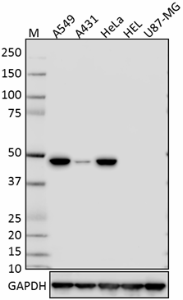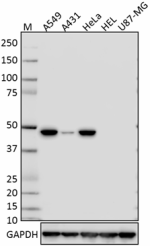- Clone
- LDK18 (See other available formats)
- Regulatory Status
- RUO
- Other Names
- Keratin 18, Keratin type I cytoskeletal 18
- Isotype
- Mouse IgG1, κ

-

Whole cell lysates (15 µg protein) from A549, A431, HeLa, HEL (negative control) and U87-MG (negative control) cells were resolved by electrophoresis (4-12% Bis-Tris gel), transferred to a nitrocellulose membrane, and probed with 0.5 µg/mL (1:1000 dilution) of purified anti-Cytokeratin 18 antibody, clone LDK18. Proteins were visualized using chemiluminescence detection by incubating the membrane with a 1:3000 dilution of HRP goat anti-mouse-IgG secondary antibody (Cat. No. 405306). Direct-Blot™ HRP anti-GAPDH antibody (1:2000 dilution, Cat. No. 649203) was used as a loading control (lower). Lane M: Molecular Weight Marker. -

HeLa cells were fixed with 2% paraformaldehyde (PFA) for 10 minutes, permeabilized with 0.5% Triton X-100 for ten minutes, and blocked with 5% FBS for 30 minutes. Then the cells were intracellularly stained with 2 µg/mL purified anti-cytokeratin 18 antibody (clone LDK18) for two hours at room temperature followed by Alexa Fluor® 594 conjugated goat anti-mouse IgG (red) for one hour at room temperature. Nuclei were counterstained with DAPI (blue). The image was captured with a 60X objective.
| Cat # | Size | Price | Quantity Check Availability | ||
|---|---|---|---|---|---|
| 689102 | 100 µg | $218.00 | |||
Cytokeratin 18, also known as keratin 18, is a type I intermediate filament protein with a molecular weight of approximately 48 kD. Cytokeratin 18 is a heterotetramer composed of two type I and two type II keratins. Cytokeratin 18 associates with cytokeratin 8 and is widely expressed in simple epithelial tissues and is expressed at high levels in some tumor tissues. Cytokeratin 18 is associated with the cytoskeleton and mutations in this protein have been linked to cryptogenic cirrhosis. Cytokeratin 18 can be modified by glycosylation, phosphorylation (Ser34 and Ser53), acetylation (Ser2), and proteolytic cleavage at amino acids 238 and 397 by caspase family members. The cytokeratin 18 protein interacts with a number of proteins including caspase 3, 14-3-3γ, 14-3-3ζ, 14-3-3σ, 14-3-3β, 14-3-3η, keratin 5, keratin 8, TNF receptor II, plakophilin 2, EGF receptor, and usherin, among others.
Product Details
- Verified Reactivity
- Human
- Antibody Type
- Monoclonal
- Host Species
- Mouse
- Immunogen
- Synthetic peptide of human keratin 18 (CSETNDTKVLRH-COOH).
- Formulation
- Phosphate-buffered solution, pH 7.2, containing 0.09% sodium azide.
- Preparation
- The antibody was purified by affinity chromatography.
- Concentration
- 0.5 mg/ml
- Storage & Handling
- The antibody solution should be stored undiluted between 2°C and 8°C.
- Application
-
WB - Quality tested
ICC - Verified
IHC-P - Reported in the literature, not verified in house - Recommended Usage
-
Each lot of this antibody is quality control tested by Western blotting. For Western blotting, the suggested use of this reagent is 0.125 - 0.5 µg/ml (1:1000 - 1:4000 dilution). For immunocytochemistry, a concentration range of 1.0 - 5.0 μg/ml is recommended. It is recommended that the reagent be titrated for optimal performance for each application.
- Application Notes
-
Additional reported applications (for the relevant formats) include: immunohistochemistry1 on formalin-fixed paraffin-embedded tissue (IHC-P).
This clone and BioLegend clone DA-7 displayed similar affinities when tested for western blot applications
-
Application References
(PubMed link indicates BioLegend citation) -
- Hosoya A. et al. 2010. Anat. Rec. (Hoboken) 293:1864. (IHC-P)
- RRID
-
AB_2629745 (BioLegend Cat. No. 689102)
Antigen Details
- Structure
- Type I intermediate filament protein, contains three coiled-coil domains, approximately 48 kD. Heterotetramer composed of two type I and two type II keratins. Cytokeratin 18 associates with cytokeratin 8.
- Distribution
-
Keratin 18 is widely expressed in normal single layer epithelial tissues (liver, pancreas) and is expressed at high levels in some tumor tissues.
- Function
- Intermediate filament protein involved with the cytoskeleton.
- Interaction
- Interacts with a number of proteins including caspase3, 14-3-3 gamma, 14-3-3 zeta, 14-3-3 sigma 14-3-3 beta, 14-3-3 eta, keratin 5, keratin 8, TNF receptor II, plakophilin 2, EGF receptor, usherin.
- Biology Area
- Cell Biology, Cell Motility/Cytoskeleton/Structure, Neuroscience, Neuroscience Cell Markers
- Molecular Family
- Intermediate Filaments
- Antigen References
-
1. Ku N, et al. 2003. Proc. Natl. Acad. Sci. USA 100:6063.
2. Kulesh DA, Oshima RG. 1989. Genomics 4:339.
3. Steinert PM, Roop DR. 1988. Ann. Rev. Biochem. 57:593.
4. Izawa I, et al. 2000. J. Biol. Chem. 275:34521.
5. Pankov R, et al. 1994. Proc. Natl. Acad. Sci. USA 91:873. - Gene ID
- 3875 View all products for this Gene ID
- UniProt
- View information about Cytokeratin 18 on UniProt.org
Other Formats
View All Cytokeratin 18 Reagents Request Custom Conjugation| Description | Clone | Applications |
|---|---|---|
| Purified anti-Cytokeratin 18 | LDK18 | WB,ICC,IHC-P |
Compare Data Across All Formats
This data display is provided for general comparisons between formats.
Your actual data may vary due to variations in samples, target cells, instruments and their settings, staining conditions, and other factors.
If you need assistance with selecting the best format contact our expert technical support team.


